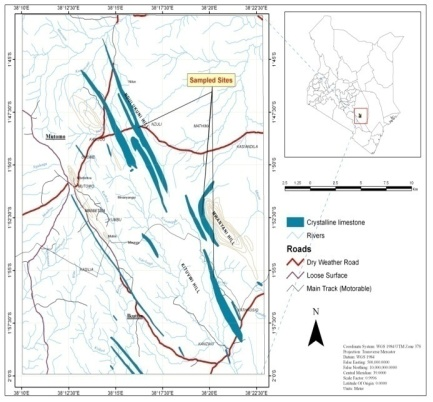Radiological Analysis of Suitability of Kitui South Limestone for use as Building Material
Radiation Physics
DOI:
https://doi.org/10.14331/ijfps.2013.330051Keywords:
Limestone, Radiation Hazard, Radionuclide, Kitui SouthAbstract
Indoor exposure arises from the soils from which the building stands and the building materials used for construction. This is because all building materials contain certain levels of natural radionuclides 238U, 232Th, and 40K. Limestone is the most commonly used building material in Kenya due to its availability and low cost. The limestone from Kitui South has not been mined to process for use but limestone mining and processing plants were being set by the time of this study. This study therefore aimed at evaluating the suitability of the limestone for use as a building material before its mining and processing begin. The activity concentrations of the limestone samples were determined and the radium equivalent, external hazard index, gamma activity index and alpha index evaluated. The results showed that the radium equivalent activity for all the samples was below the recommended limit of 370Bqkg-1 and all the radiation hazard indices were below a unit. Therefore, the limestone can be used as building material or for manufacture of building materials without any restrictions.
Downloads
References
Achola, S., Patel, J., Mustapha, A., & Angeyo, H. (2012). Natural radioactivity and external dose in the high background radiation area of Lambwe East, Southwestern Kenya. Radiation protection dosimetry, 152(4), 423-428.
Ademola, J., & Oguneletu, P. (2005). Radionuclide content of concrete building blocks and radiation dose rates in some dwellings in Ibadan, Nigeria. Journal of environmental radioactivity, 81(1), 107-113.
Amrani, D., & Tahtat, M. (2001). Natural radioactivity in Algerian building materials. Applied Radiation and Isotopes, 54(4), 687-689.
Aslam, M., Orfi, S., Khan, K., & Jabbar, A. (2002). Radiological significance of Pakistani marble used for construction of dwellings. Journal of radioanalytical and nuclear chemistry, 253(3), 483-487.
Beretka, J., & Matthew, P. (1985). Natural radioactivity of Australian building materials, industrial wastes and by-products. Health physics, 48(1), 87.
Commission, E. (1999). Radiological protection principles concerning the natural radioactivity of building materials. Radiation Protection, 112, 16.
Dhanya Balakrishnan, U. A., Abraham, J. P., Rajagopalan, M., & Jojo, P. (2012). A Study on Activity Concentration of Natural Radionuclide of Building Materials in Kochi. International Journal of Fundamental Physical Sciences IJFPS, 2(3), 41-43.
Gupta, M., & Chauhan, R. (2011). Estimating radiation dose from building materials. Iranian Journal of Radiation Research, 9(3), 187-194.
Hashim, N., Rathore, I., Kinyua, A., & Mustapha, A. (2004). Natural and artificial radioactivity levels in sediments along the Kenyan coast. Radiation physics and chemistry, 71(3-4), 805-806.
Icrp. (1991). 1990 Recommendations of the International Commission Radiological Protection: Elsevier Science Health Science Division.
Jibiri, N., & Emelue, H. (2008). Soil radionuclide concentrations and radiological assessment in and around a refining and petrochemical company in Warri, Niger Delta, Nigeria. Journal of Radiological Protection, 28(3), 361.
Krieger, R. (1981). Radioactivity of construction materials. Betonwerk Fertigteil Techn, 47, 468.
Lu, X., Li, N., Yang, G., & Zhao, C. (2013). Assessment of Natural Radioactivity and Radiological Hazards in Building Materials Used in Yan’an, China. Health physics, 104(3), 325-331.
Mahmoud, K. (2007). Radionuclide content of local and imported cements used in Egypt. Journal of Radiological Protection, 27(1), 69.
Mohanty, A., Sengupta, D., Das, S., Vijayan, V., & Saha, S. (2004). Natural radioactivity in the newly discovered high background radiation area on the eastern coast of Orissa, India. Radiation measurements, 38(2), 153-165.
Mountford, P., & Temperton, D. (1992). Recommendations of the international commission on radiological protection (ICRP) 1990. European Journal of Nuclear Medicine and Molecular Imaging, 19(2), 77-79.
Mustapha, A., Patel, J., & Rathore, I. (1999). Assessment of human exposures to natural sources of radiation in Kenya. Radiation protection dosimetry, 82(4), 285-292.
Radiation, U. N. S. C. O. T. E. O. A. (2000). Sources and Effects of Ionizing Radiation: Sources (Vol. 1): United Nations Publications.
Radiation, U. N. S. C. o. t. E. o. A. (2000). Sources and Effects of Ionizing Radiation: Sources: United Nations Scientific Committee.
Strålehygiejne, S. I. f., & Säteilyturvakeskus. (1986). Naturally Occurring Radiation in the Nordic Countries: Recommendations: Radiation Protection Institutes in Denmark, Finland, Iceland, Norway and Sweden.
Tufail, M., & Hamid, T. (2007). Natural radioactivity hazards of building bricks fabricated from saline soil of two districts of Pakistan. Journal of radiological protection, 27(4), 481.
Waswa, A. K. (2011). Geology and the Minerals of Kitui South. PhD, University of Nairobi
Nairobi
Xinwei, L., Lingqing, W., Xiaodan, J., Leipeng, Y., & Gelian, D. (2006). Specific activity and hazards of Archeozoic-Cambrian rock samples collected from the Weibei area of Shaanxi, China. Radiation protection dosimetry, 118(3), 352-359.

Published
How to Cite
Issue
Section
License
Copyright (c) 2013 Fundamental Journals

This work is licensed under a Creative Commons Attribution-NonCommercial 4.0 International License.










